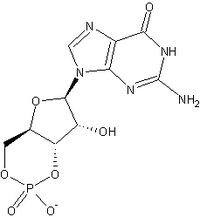Assessment |
Biopsychology |
Comparative |
Cognitive |
Developmental |
Language |
Individual differences |
Personality |
Philosophy |
Social |
Methods |
Statistics |
Clinical |
Educational |
Industrial |
Professional items |
World psychology |
Biological: Behavioural genetics · Evolutionary psychology · Neuroanatomy · Neurochemistry · Neuroendocrinology · Neuroscience · Psychoneuroimmunology · Physiological Psychology · Psychopharmacology (Index, Outline)
| style="background: #F8EABA; text-align: center;" colspan="2" | Cyclic guanosine monophosphate |
|---|---|

| |
| Identifiers | |
| CAS number | 7665-99-8 |
| PubChem | 295 |
| MeSH | Cyclic+GMP |
| Properties | |
| Molecular formula | C10H12N5O7P |
| Molar mass | 345.206 |
| Hazards | |
| style="background: #F8EABA; text-align: center;" colspan="2" | Except where noted otherwise, data are given for materials in their standard state (at 25 °C, 100 kPa) Infobox disclaimer and references |
Cyclic guanosine monophosphate (cGMP) is a cyclic nucleotide derived from guanosine triphosphate (GTP). cGMP acts as a second messenger much like cyclic AMP, most notably by activating intracellular protein kinases in response to the binding of membrane-impermeable peptide hormones to the external cell surface.
Synthesis[]
cGMP synthesis is catalyzed by guanylate cyclase (GC), which converts GTP to cGMP. Membrane-bound GC is activated by peptide hormones such as the atrial natriuretic factor, while soluble GC is typically activated by nitric oxide to stimulate cGMP synthesis.
Effects[]
cGMP is a common regulator of ion channel conductance, glycogenolysis, and cellular apoptosis. It also relaxes smooth muscle tissues. In blood vessels, relaxation of vascular smooth muscles lead to vasodilation and increased blood flow.
cGMP is a secondary messenger in phototransduction in the eye. In the photoreceptors (rods and cones) of the human eye, the absence of light activates phosphodiesterase, which upregulates cGMP by catalyzing its conversion from guanosine monophosphate (GMP). cGMP opens sodium ion channels, which leads to the depolarization of the photoreceptor's plasma membrane, which opens calcium ion channels, which leads to the release of neurotransmitters by the photoreceptor cell, which in turn signals other cells inbedded in the retina and leads to the transfer of information from the eye to the brain and vision.
Degradation[]
Cyclic nucleotide phosphodiesterases (PDE 1-6) degrade cGMP by hydrolyzing cGMP into 5'-GMP.
Phosphodiesterase inhibitors prevent the degradation of cGMP, thereby enhancing and/or prolonging its effects. For example, Sildenafil (Viagra) enhances the vasodilatory effects of cGMP within the corpus cavernosum by inhibiting PDE 5 (or PDE V). This is used as a treatment for erectile dysfunction.
Protein kinase activation[]
cGMP is involved in the regulation of some protein-dependent kinases. For example, PKG (protein kinase G) is a dimer consisting of one catalytic and one regulatory unit, with the regulatory units blocking the active sites of the catalytic units.
cGMP binds to sites on the regulatory units of PKG and activates the catalytic units, enabling them to phosphorylate their substrates. Unlike with the activation of some other protein kinases, notably PKA, the PKG is activated but the catalytic and regulatory units do not disassociate.
References[]
- Francis SH, Corbin JD (1999). Cyclic nucleotide-dependent protein kinases: intracellular receptors for cAMP and cGMP action.. Crit Rev Clin Lab Sci 36 (4): 275-328. PMID 10486703.
See also[]
| Nucleic acids edit |
|---|
| Nucleobases: Adenine - Thymine - Uracil - Guanine - Cytosine - Purine - Pyrimidine |
| Nucleosides: Adenosine - Uridine - Guanosine - Cytidine - Deoxyadenosine - Thymidine - Deoxyguanosine - Deoxycytidine |
| Nucleotides: AMP - UMP - GMP - CMP - ADP - UDP - GDP - CDP - ATP - UTP - GTP - CTP - cAMP - cGMP |
| Deoxynucleotides: dAMP - dTMP - dUMP - dGMP - dCMP - dADP - dTDP - dUDP - dGDP - dCDP - dATP - dTTP - dUTP - dGTP - dCTP |
| Nucleic acids: DNA - RNA - LNA - PNA - mRNA - ncRNA - miRNA - rRNA - siRNA - tRNA - cDNA - snRNA - snoRNA - mtDNA - Oligonucleotide
|
| This page uses Creative Commons Licensed content from Wikipedia (view authors). |